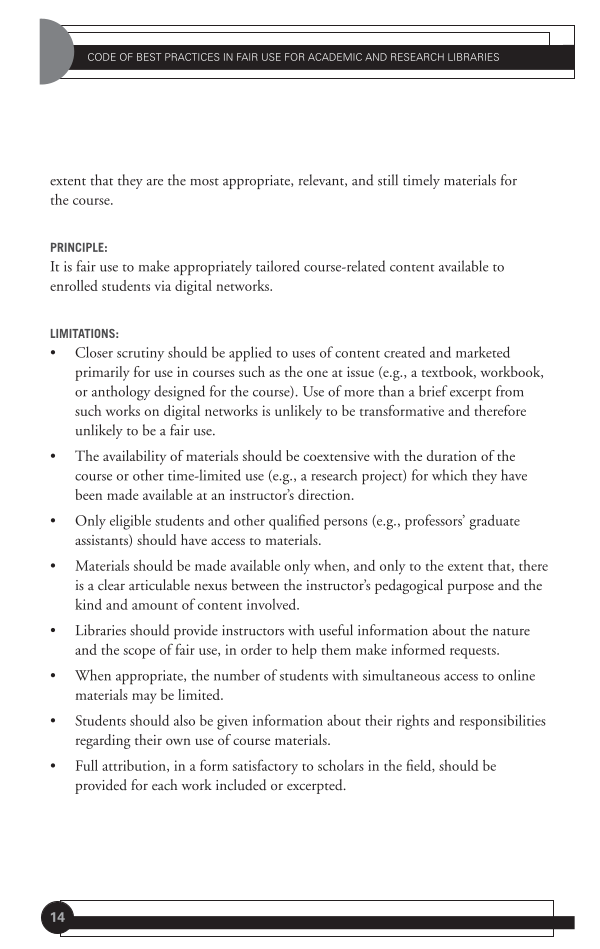CODE OF BEST PRACTICES IN FAIR USE FOR ACADEMIC AND RESEARCH LIBRARIES
14
extent that they are the most appropriate, relevant, and still timely materials for
the course.
PRINCIPLE:
It is fair use to make appropriately tailored course-related content available to
enrolled students via digital networks.
LIMITATIONS:
• Closer scrutiny should be applied to uses of content created and marketed
primarily for use in courses such as the one at issue (e.g., a textbook, workbook,
or anthology designed for the course). Use of more than a brief excerpt from
such works on digital networks is unlikely to be transformative and therefore
unlikely to be a fair use.
• The availability of materials should be coextensive with the duration of the
course or other time-limited use (e.g., a research project) for which they have
been made available at an instructor’s direction.
• Only eligible students and other qualified persons (e.g., professors’ graduate
assistants) should have access to materials.
• Materials should be made available only when, and only to the extent that, there
is a clear articulable nexus between the instructor’s pedagogical purpose and the
kind and amount of content involved.
• Libraries should provide instructors with useful information about the nature
and the scope of fair use, in order to help them make informed requests.
• When appropriate, the number of students with simultaneous access to online
materials may be limited.
• Students should also be given information about their rights and responsibilities
regarding their own use of course materials.
• Full attribution, in a form satisfactory to scholars in the field, should be
provided for each work included or excerpted.
14
extent that they are the most appropriate, relevant, and still timely materials for
the course.
PRINCIPLE:
It is fair use to make appropriately tailored course-related content available to
enrolled students via digital networks.
LIMITATIONS:
• Closer scrutiny should be applied to uses of content created and marketed
primarily for use in courses such as the one at issue (e.g., a textbook, workbook,
or anthology designed for the course). Use of more than a brief excerpt from
such works on digital networks is unlikely to be transformative and therefore
unlikely to be a fair use.
• The availability of materials should be coextensive with the duration of the
course or other time-limited use (e.g., a research project) for which they have
been made available at an instructor’s direction.
• Only eligible students and other qualified persons (e.g., professors’ graduate
assistants) should have access to materials.
• Materials should be made available only when, and only to the extent that, there
is a clear articulable nexus between the instructor’s pedagogical purpose and the
kind and amount of content involved.
• Libraries should provide instructors with useful information about the nature
and the scope of fair use, in order to help them make informed requests.
• When appropriate, the number of students with simultaneous access to online
materials may be limited.
• Students should also be given information about their rights and responsibilities
regarding their own use of course materials.
• Full attribution, in a form satisfactory to scholars in the field, should be
provided for each work included or excerpted.


































